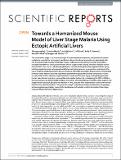Towards a Humanized Mouse Model of Liver Stage Malaria Using Ectopic Artificial Livers
Author(s)
Ng, Shengyong; March, Sandra; Galstian, Ani; Gural, Nil; Stevens, Kelly R.; Mota, Maria M.; Bhatia, Sangeeta N.; March-Riera, Sandra; Prado, Mariana; Bhatia, Sangeeta N; ... Show more Show less
DownloadTowards a humanized.pdf (1.603Mb)
PUBLISHER_CC
Publisher with Creative Commons License
Creative Commons Attribution
Terms of use
Metadata
Show full item recordAbstract
The malaria liver stage is an attractive target for antimalarial development, and preclinical malaria models are essential for testing such candidates. Given ethical concerns and costs associated with non‐human primate models, humanized mouse models containing chimeric human livers offer a valuable alternative as small animal models of liver stage human malaria. The best available human liver chimeric mice rely on cellular transplantation into mice with genetically engineered liver injury, but these systems involve a long and variable humanization process, are expensive, and require the use of breeding-challenged mouse strains which are not widely accessible. We previously incorporated primary human hepatocytes into engineered polyethylene glycol (PEG)-based nanoporous human ectopic artificial livers (HEALs), implanted them in mice without liver injury, and rapidly generated human liver chimeric mice in a reproducible and scalable fashion. By re-designing the PEG scaffold to be macroporous, we demonstrate the facile fabrication of implantable porous HEALs that support liver stage human malaria (P. falciparum) infection in vitro, and also after implantation in mice with normal liver function, 60% of the time. This proof-of-concept study demonstrates the feasibility of applying a tissue engineering strategy towards the development of scalable preclinical models of liver stage malaria infection for future applications.
Date issued
2017-03Department
Institute for Medical Engineering and Science; Harvard University--MIT Division of Health Sciences and Technology; Massachusetts Institute of Technology. Center for International Studies; Massachusetts Institute of Technology. Department of Biological Engineering; Massachusetts Institute of Technology. Department of Electrical Engineering and Computer Science; Massachusetts Institute of Technology. Department of Mechanical EngineeringJournal
Scientific Reports
Publisher
Nature Publishing Group
Citation
Ng, Shengyong, Sandra March, Ani Galstian, Nil Gural, Kelly R. Stevens, Maria M. Mota, and Sangeeta N. Bhatia. “Towards a Humanized Mouse Model of Liver Stage Malaria Using Ectopic Artificial Livers.” Scientific Reports 7 (March 31, 2017): 45424.
Version: Final published version
ISSN
2045-2322